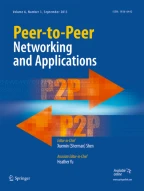Abstract
In this paper, we propose a behavior-based detection that can discriminate Distributed Denial of Service (DDoS) attack traffic from legitimated traffic regardless to various types of the attack packets and methods. Current DDoS attacks are carried out by attack tools, worms and botnets using different packet-transmission rates and packet forms to beat defense systems. These various attack strategies lead to defense systems requiring various detection methods in order to identify the attacks. Moreover, DDoS attacks can craft the traffics like flash crowd events and fly under the radar through the victim. We notice that DDoS attacks have features of repeatable patterns which are different from legitimate flash crowd traffics. In this paper, we propose a comparable detection methods based on the Pearson’s correlation coefficient. Our methods can extract the repeatable features from the packet arrivals in the DDoS traffics but not in flash crowd traffics. The extensive simulations were tested for the optimization of the detection methods. We then performed experiments with several datasets and our results affirm that the proposed methods can differentiate DDoS attacks from legitimate traffics.
Similar content being viewed by others
References
MIT Lincoln Laboratory, “Lincoln Laboratory Scenario (DDoS) 1.0,” Massachusetts Institute of Technology (MIT), 1999. Available: http://www.ll.mit.edu/mission/communications/ist/corpora/ideval/data/2000/LLS_DDOS_1.0.html
US CERT 04, “W32/MyDoom.B Virus,” United States Computer Emergency Readiness Team, Available: http://www.us-cert.gov/cas/techalerts/TA04-028A.html, 2 Febuary 2004
Rajab MA, Zarfoss J, Monrose F and Terzis A (2006) “A multifaceted approach to understanding the Botnet Phenomenon.” In: Proceedings of the 6th ACM SIGCOMM conference on Internet measurement, pp. 41–52, October 2006
Oikonomou G and Mirkovic J (2009) “Modeling human behavior for defense against flash-crowd attacks.” In: Proceedings of IEEE International Conference on Communications 2009 (ICC’09), pp. 1–6, 11 August 2009
Xie Y, Yu SZ (2009) A large-scale hidden Semi-Markov model for anomaly detection on user browsing behaviors networking. IEEE/ACM Trans Networking 17(1):54–65
Xie Y, Yu SZ (2009) Monitoring the application-layer DDoS attacks for popular websites. IEEE/ACM Trans Networking 17(1):15–25
Yi F, Yu S, Zhou W, Hai J, Bonti A (2008) Source-based filtering scheme against DDOS attacks. Int J Database Theory Appl 1(1):9–22
Feinstein L, Schnackenberg D, Balupari R and Kindred D (2003) “Statistical approaches to DDoS attack detection and response.” In: Proceedings of the DARPA Information Survivability Conference and Exposition, vol. 1, IEEE CS Press, 22–24 April 2003, pp. 303–314
Khan L, Awad M and Thuraisingham B (2007) “A new intrusion detection system using support vector machines and hierarchical clustering.” The International Journal on Very Large Data Bases (The VLDB Journal), vol. 16, no. 4, pp. 507–521, Springer-Verlag, New York, October 2007
Yu S, Thapngam T, Liu J, Wei S and Zhou W (2009) “Discriminating DDoS flows from flash crowds using information distance.” In: Proceedings of the 3rd IEEE International Conference on Network and System Security (NSS’09), 18–21 October 2009
Chonka A, Singh J, Zhou W (2009) Chaos theory based detection against network mimicking DDoS attacks. IEEE Commun Lett 13:717–719
Carlinet Y, Cherkaoui O, Dressler F, Ehinger C, Fadlallah A, Muenz G, Mußner M, Paul O, Serhrouchni A, Sloman M, and Yusuf S (2004) “Distributed adaptive security by Programmable Firewall,” DIADEM Firewall Consortium, retrieved 6 September 2008, Available: http://www.diadem-firewall.org/documents/Diadem%20Firewall%20-%20D3%20-%20Attack%20Requirements%20Specification.pdf, June 2004
Chen Y, Hwang K (2006) Collaborative detection and filtering of shrew DDoS attacks using spectral analysis. J Parallel Distr Com 66(9):1137–1151
Tuncer T and Tatar Y (2008) “Detection SYN Flooding Attacks Using Fuzzy Logic.” In: Proceedings of International Conference on Information Security and Assurance (ISA’08), pp. 321–325, 24–26 April 2008
Kuzmanovic A and Knightly E (2003) “Low-Rate TCP –Targeted Denial of Service Attacks (The Shrew vs. the Mice and Elephants).” In: Proceedings of ACM SIGCOMM 2003, Kalrushe, Germany, pp. 75–86, August 2003
Chen Y and Hwang K (2007) “Spectral analysis of TCP flows for defense against reduction-of-quality attacks.” In: Proceedings of the 2007 IEEE International Conference on Communications (ICC’07), pp. 1203–1210, June 2007
Douligeris C, Mitrokotsa A (2004) DDoS attacks and defense mechanisms: Classification and state of the art. Comput Netw 44(5):643–666
Peng T, Leckie C and Ramamohanarao K (2007) “Survey of network-based defense mechanisms countering the DoS and DDoS problems.” In: ACM Computing Surveys, Vol. 39, No. 1, April 2007
Mirkovic J, Reiher P (2004) A Taxonomy of DDoS attack and DDoS defense mechanisms. ACM SIGCOMM Comput Commun Rev 34(2):39–53
Kreyszig E (2006) Advanced Engineering Mathematics, 9th edn. Wiley, Singapore
M. Arlitt and T. Jin “1998 World Cup Web Site Access Logs,” August 1998. Available: http://www.acm.org/sigcomm/ITA/
Author information
Authors and Affiliations
Corresponding author
Rights and permissions
About this article
Cite this article
Thapngam, T., Yu, S., Zhou, W. et al. Distributed Denial of Service (DDoS) detection by traffic pattern analysis. Peer-to-Peer Netw. Appl. 7, 346–358 (2014). https://doi.org/10.1007/s12083-012-0173-3
Received:
Accepted:
Published:
Issue Date:
DOI: https://doi.org/10.1007/s12083-012-0173-3
